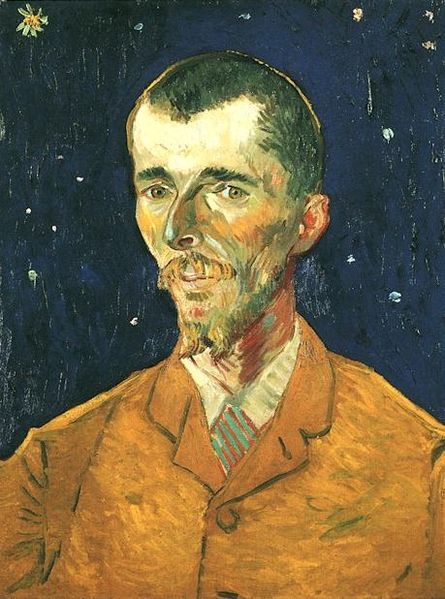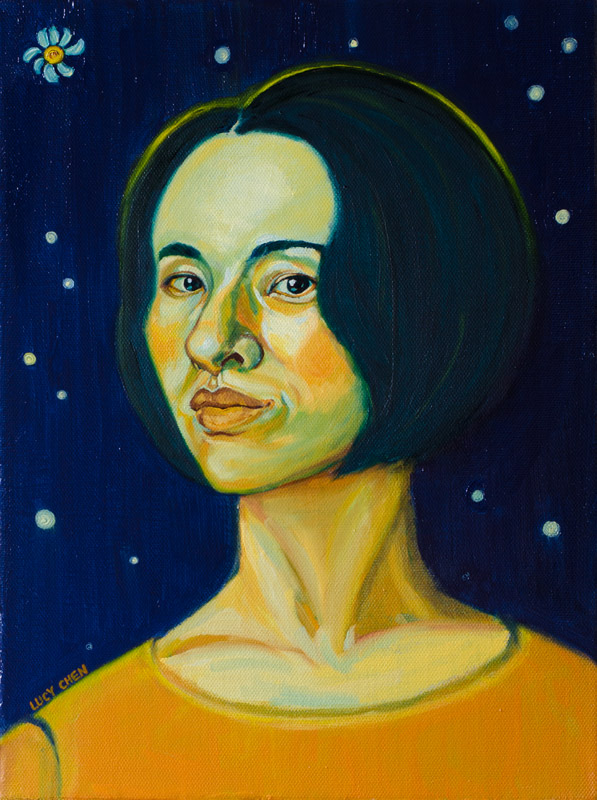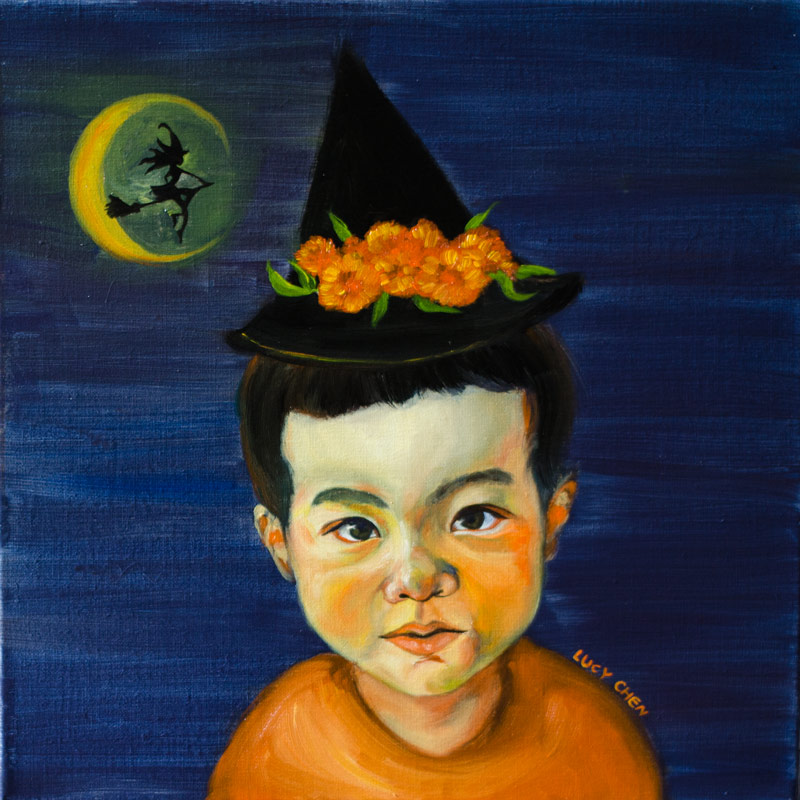When it comes to color, we can certainly learn, or even better, steal from the masters. My all time favorite artist is Vincent Van Gogh, who is my inspiration, mentor, and I dare tell you, my dream-lover!
Here is how I used the great artist’s idea in two of my own paintings, one a self portrait and the other a portrait of my 1-year-old daughter.
The Inspiration

“Portrait of Eugène Boch” may not be the most famous Van Gogh but it is one of my favorite. This is what Vincent said in his letter to Theo about his idea for the painting,
“I should like to paint the portrait of an artist friend who dreams great dreams, who works as the nightingale sings, because it is his nature. This man will be fair-haired. I should like to put my appreciation, the love I have for him, into the picture. So I will paint him as he is, as faithfully as I can – to begin with. But that is not the end of the picture. To finish it, I shall be an obstinate colourist. I shall exaggerate the fairness of the hair, arrive at tones of orange, chrome, pale yellow. Behind the head – instead of painting the ordinary wall of the shabby apartment, I shall paint infinity, I shall do a simple background of the richest, most intense blue that I can contrive, and by this simple combination, the shining fair head against this rich blue background, I shall obtain a mysterious effect, like a star in the deep blue sky.”
Although he didn’t paint himself, I believed this portrait was every bit as Eugène Boch as Vincent Van Gogh. And I was inspired to paint another “Artist Who Dreams Great Dreams”.
My Self Portrait

The master’s reference could certainly help to make the painting process easy and smooth. However, it is important to observe how Van Gogh applied the colors, especially how he handled the colors in the shadow areas.
My Palette:
1. Titanium White
2. Chrome Yellow Hue
3. Burnt Sienna
4. Cadmium Orange, and
5. Cobalt Blue.
Shadow areas:
Blues, greens and oranges of varying intensity and value are used for the shadow areas of the portrait. To make these colors, I mixed:
1. Cobalt Blue with Cadmium Orange
2. Cobalt Blue with Chrome Yellow
3. Burnt Sienna with Cadmium Orange
Light Areas:
The light areas aren’t as colorful as the shadows. I simply used a mixture of Chrome Yellow with Titanium White for the light areas. For the orange cheeks, I added some Cadmium Orange to the mix.
Painting Process:
I think Van Gogh might have painted this alla prima, as with most of his other paintings. So working wet-on-wet, I also painted mine in one session:
1. Firstly I made a pencil sketch of my head on the canvas by looking in the mirror.
2. I then painted the night sky background with a mix of Cobalt Blue and some Cadmium Orange.
3. Observing how the light fell on my own face, I applied colour to the canvas following my findings of Van Gogh’s use of colours. Working from dark to light, I mixed colours as I progressed, but pre-mixing the colours would also be a good idea.
4. I worked on the whole portrait at one time, applying similar colours to different areas, and used a dry blending brush to mix the wet paint and smooth the edges.
5. Hair, cloth and the stars were painted last.
The portrait and the painting process itself made me happy. Because with it, I was brave enough to admit to myself and also tell the world that I am an “artist who dreams great dreams”.
Portrait of Chloe

If the self portrait was more of a “copy” than a “steal”, then my portrait of Chloe was certainly much more creative. Having already experimented with this palette, I was free to let my imagination take the driving seat.
I followed the same process, used the same palette with the addition of Ivory Black, and completed the painting in 3-4 hours. Two things to note are:
1. I worked from a photo of Chloe, because it would be inane to ask a 1-year-old to sit still. I used photo references for all of my children’s portraits.
2. I used Ivory Black in Chloe’s eyes, the hat, and to paint the flying witch.
Both my husband and Chloe herself said that I was the flying witch when they saw the painting. This certainly wasn’t my initial intention, but it seemed to have turn out as such.
So here is how I interpreted the master’s painting, especially his use of color, to paint two portraits of my own. It is only my way, and it certainly isn’t the only way or the “right” way to do it. Hopefully, this article has inspired some of you to study Van Gogh in more depth, or to experiment with his use of colors. And perhaps you would like to share your tips and insights, too.
Guest artist/author: Lucy Chen is a portrait artist based in Sydney, Australia. She likes to experiment with colors and symbols in her works to express feelings and tell stories. To find out more about her and her works, visit www.LucyChenFineArt.com
****
Thank you Lucy for sharing your inspiration and for teaching us how to put a modern day twist on an old master’s work!
Thanks for visiting FineArtTips.com. You can see my art on my website, LoriMcNee.com, and let’s meet on Facebook Fine Art Tips Facebook Fan Page, on Twitter, Google Plus and on Pinterest. Be sure and check out and my fine art prints and notecards on Fine Art America.! ~Lori








Excellent article Lucy! I look forward to seeing your new work and your sharing! Now I see that You are an excellent communicator with Words also! Mahalo to You and to Lori McNee, and her excellent page! Lori is truly good for art!
Thank you Timothy! Lucy really did a great job with this post and it was such a compliment to my blog. I am glad you are enjoying your visit here…
Lori 🙂
Well done Lucy, love the blog and your creativity.
Thank you, Janet. One of the best things about being online is meeting fellow artists like you and Lori. 🙂
Awesome post Lucy! Thanks so much for sharing your thoughts and expertise with us! I very much enjoyed learning more about your process! Thank You!
Sheila, I am so happy you enjoyed Lucy’s great guest post. She did a great job describing her process.
Happy painting,
Lori
Thanks, Sheila. I’m very happy that you enjoyed my post, too. Let me know if you try something similar, or Van Gogh inspired, because I LOVE him!
I love the Van Gogh inspiration. The portrait of Chloe is so timely for Halloween and so nicely done! Great painting and post Lucy!
Yes, it is perfect for Halloween! Van Gogh would be proud…
Lori 🙂
Thank you. Yes, I think it’s quite good for Halloween, too!
Your tips are so helpful to me. Thank you for what you are posting. Really enjoyed this exercise.
Hello Jamie, thanks for stopping by and commenting. I am so glad you found this post helpful. I really enjoyed it too!
Lori 🙂
Thank you for the sweet comment, Jamie.
You’re encouraging me to share more 🙂
Hi,I shouldn’t be bothering you..but I’m just so discouraged…been painting people’s pets.
I do it according to a photo…when I’m finished my friend’s say they LOVE it……a month later they start,
One doesn’t like the blue background, one dog has too much orange,
One hasn’t enough brown ( in real life)….. The photo showed black , beige and orange…..
One dog was perfect, but his color changed as he got older…..
When I take them back, to ? Fix them, I start to ruin the original…….which took me weeks to do!?!?!
Now I feel like the heart has gone out of me, and I’ve lost all my confidence….
They start with all kinds of praise, then the criticism …….but weeks later
How do I get that happy confident feeling back? It is literally,”Gone with the Wind”.
Hello Terry, I am sorry you are feeling so frustrated. Commissions can either be joyous, or a stressful at times. I am just finishing up one myself. The client is very wealthy, and persnickety. The best way is to take charge, be professional and set time limits. Do you have a contract? It might be a good idea. Here is a blog post that will help you gain confidence. https://www.finearttips.com/2009/11/commissioned-art-%E2%80%93-tips-to-make-it-a-success/
Also, next time make sure to give your clients a timeframe in which they can complain! Yes you want them happy, but you cannot allow them to micromanage you to the point of losing your own artistic identity. Once they approve, pay and take possession of the painting, you really should not need to make changes. That should all be done during the working process. You might want to add a clause about that in your contract.
I hope this helps! Now, go paint something for yourself!!! 🙂 ~Lori
Makes me wonder if I should take art commission out from my business…
Why??? Will you explain?
Because Terry’s experience with commission work is quite disheartening. Isn’t it?